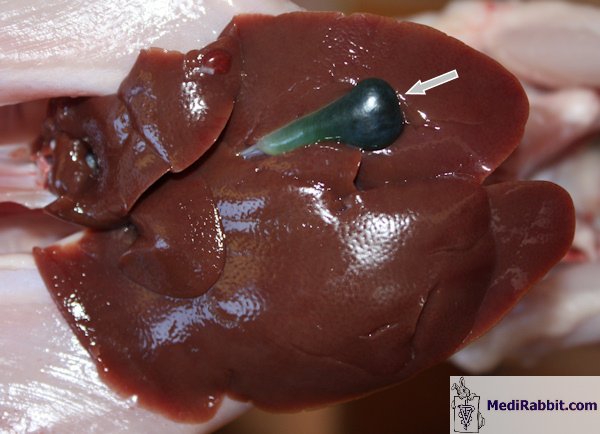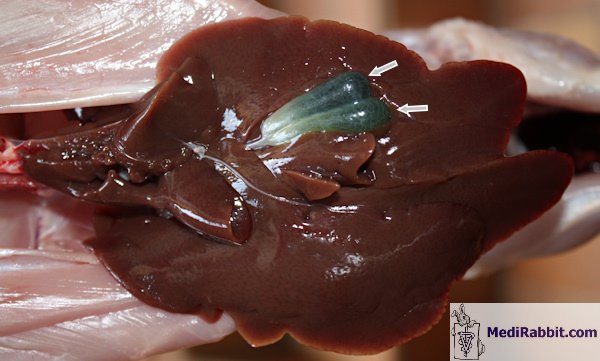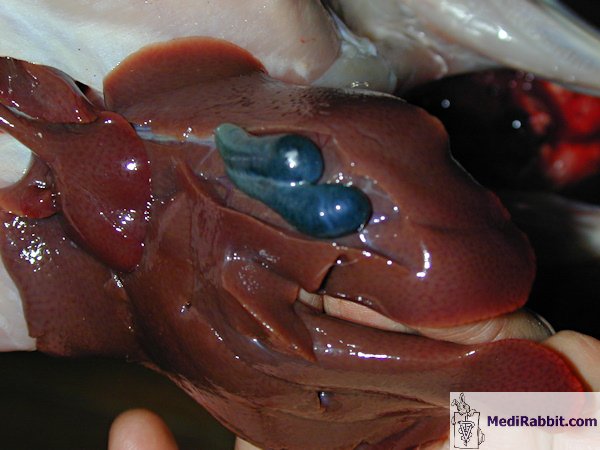Double or duplicate gallbladder in a Harlequin breed
rabbit
Michel Gruaz
|
MediRabbit.com is funded solely by the generosity of
donors. Every donation, no matter what the
size, is appreciated and will aid in the continuing research of medical care
and health of rabbits.
Thank
you |
|
The liver is a large organ that occupies a specific space in the abdomen. In rabbits, the liver is composed of two main lobes, right and left, that are separated by a deep median cleft. Between these lobes are two accessory lobes: the cranial lobe and the caudal lobe. The liver maintains its position in the abdominal region due to ligaments that attach to the diaphragm and the dorsal wall of the abdomen. The liver plays a central role in the synthesis of proteins, in the
metabolism of sugars, and the storage of nutrients. It is also involved in
the degradation of toxins and the treatment of organic waste produced by
cells of the body. In addition to its primary function, it plays a crucial
role in the endocrine system by stimulating various biochemical reactions
that are vital for the body's optimal functioning. It also has an exocrine
function, responsible for bile secretion. The latter is a viscous liquid that
facilitates the digestion of fats. In rabbits, bile is produced continuously
and stored in the gallbladder. It is then secreted into the small intestine
(duodenum) through the bile ducts. The vesicle has a pear-like shape. The gallbladder is located in the right
cranial lobule, inside the depression on the caudal surface. It is
pear-shaped. The gall of rabbits is primarily composed of billiverdon,
which possesses strong antioxidant properties, and not of bilirubine. The
produced quantity is substantial, with each rabbit producing approximately
250 millilitres per day. This is equivalent to seven times the quantity
produced by a dog. Congenital double gallbladder A double or duplicate gallbladder is a rare
congenital anomaly. During the embryonic phase, the first stage gallbladder
(primordium) bifurcates, resulting in a double or duplicate vesicle. This
deformation appears to be more prevalent among herbivorous animals, such as
cows (1 in 28 calves) and sheep (1 in 85). There have been reports of cases
in rabbits. It has been observed that there are different types of
gallbladder duplication: ·
Bifide, bilobed type: a membrane divides the vesicle
is divided in its length, creating two side by side pockets; ·
Double type: presence of 2 separate gallbladders.
Their bile ducts can join before delivering bile into the small intestine, or
remain separate. This congenital anomaly has been linked to a number of clinical signs.
Abdominal pain at stomach level has been associated with a double
gallbladder, which can lead to a lack of appetite in rabbits. In other
animals, signs associated with a double gallbladder include biliary colics,
pain, acute inflammation of the gallbladder (cholecystitis), and the presence
of gallstones (cholelithiasis).
More information
Milot
L, Partensky C, Scoazec JY, Valette PJ, Pilleul F. Double gallbladder
diagnosed on contrast-enhanced MR cholangiography with mangafodipir
trisodium. AJR Am J Roentgenol. 2005;184(3 Suppl):S88-90. Moores AL, Gregory SP. Duplex
gall bladder associated with choledocholithiasis, cholecystitis, gall bladder
rupture and septic peritonitis in a cat. J Small Anim Pract.
2007;48(7):404-9. Stingl H. [Vesica fellea duplex and vesica
fellea divisa in rabbits (Oryctolagus cuniculus)]. Berl Munch
Tierarztl Wochenschr. 1971;84(21):420-2.
Stolkind E. Double gall-bladder
report of a case and review of 38 cases. British Journal of Surgery
Vol 27 (108), 1940: 760–766.
|
e-mail: info@medirabbit.com






